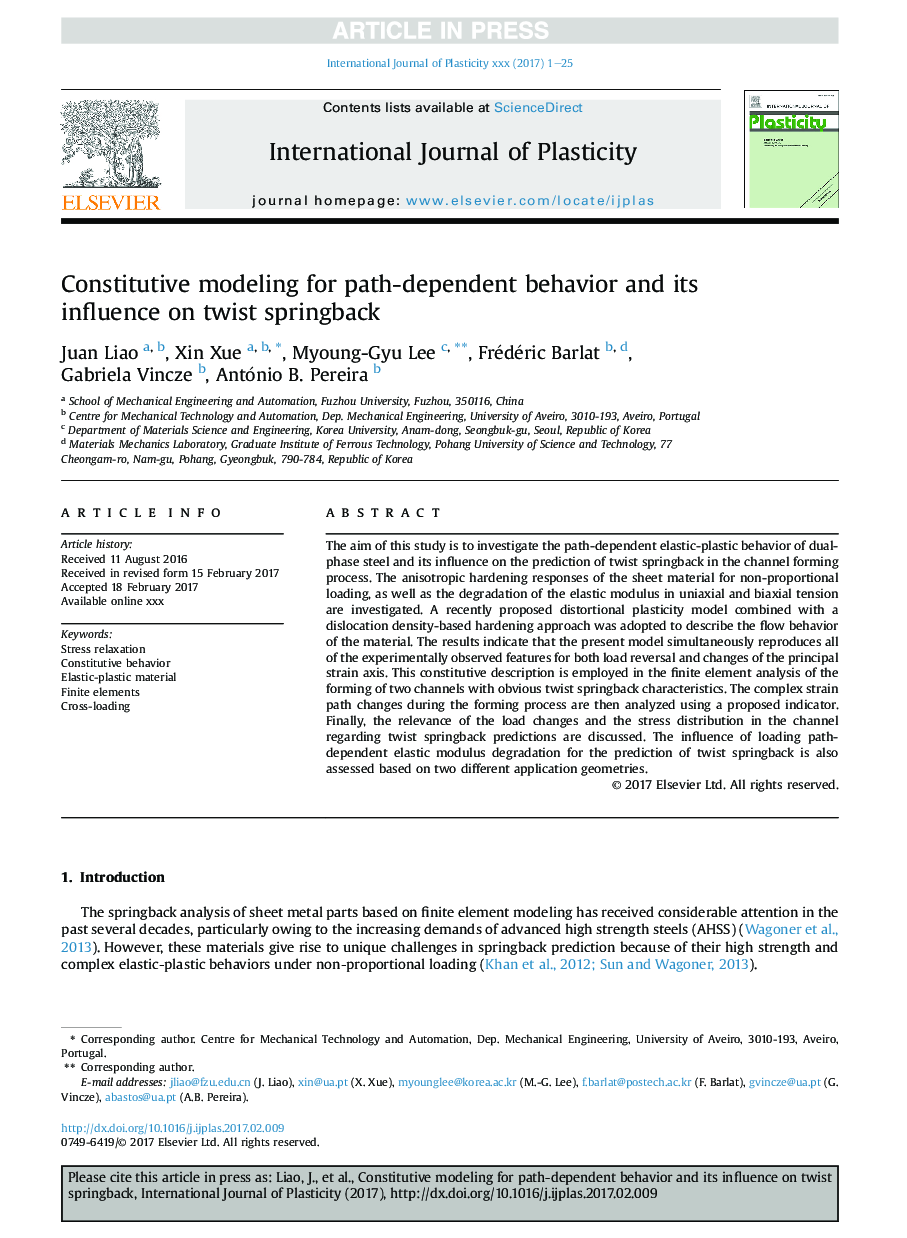| کد مقاله | کد نشریه | سال انتشار | مقاله انگلیسی | نسخه تمام متن |
|---|---|---|---|---|
| 5016684 | 1465580 | 2017 | 25 صفحه PDF | دانلود رایگان |
عنوان انگلیسی مقاله ISI
Constitutive modeling for path-dependent behavior and its influence on twist springback
ترجمه فارسی عنوان
مدل سازی سازمانی برای رفتار وابسته به مسیر و تأثیر آن بر چرخش چرخشی
دانلود مقاله + سفارش ترجمه
دانلود مقاله ISI انگلیسی
رایگان برای ایرانیان
کلمات کلیدی
آرامش استرس، رفتار سازمانی، مواد پلاستیکی الاستیک، عناصر محدود بارگذاری مجدد،
ترجمه چکیده
هدف از این مطالعه بررسی رفتار پلیاستر - پلاستیکی وابسته به مسیر فولاد دو مرحله ای و تاثیر آن بر پیش بینی عقب گرد شدن پیچ در فرآیند تشکیل کانال است. پاسخهای سخت کننده انییزوتروپیک مواد ورق برای بارگذاری غیر متناسب و همچنین تخریب مدول الاستیک در تنش های دو طرفه و دو طرفه مورد بررسی قرار گرفته است. برای توصیف رفتار جریان مواد، یک مدل پلاستیکی تحریف شده همراه با یک روش سخت شدن مبتنی بر تراکم جابجایی به کار گرفته شد. نتایج نشان می دهد که مدل کنونی به طور همزمان تمام ویژگی های مشاهده شده تجربی را برای هر دو تغییر بار و تغییرات محور کرنش اصلی بازتولید می کند. این توصیف سازنده در تجزیه و تحلیل عناصر محدود از تشکیل دو کانال با ویژگی های برگشت پذیری واضح آشکار استفاده می شود. مسیر پیمانه پیچیده در طول فرآیند تشکیل، سپس با استفاده از یک شاخص پیشنهادی مورد تجزیه و تحلیل قرار می گیرد. در نهایت، ارتباط تغییرات بار و توزیع استرس در کانال در مورد پیش بینی چرخش چرخشی بحث شده است. تأثیر بار تخلخل مدول الاستیسیته وابسته به بار برای پیش بینی چرخش چرخشی نیز بر اساس دو هندسه مختلف کاربردی ارزیابی می شود.
موضوعات مرتبط
مهندسی و علوم پایه
سایر رشته های مهندسی
مهندسی مکانیک
چکیده انگلیسی
The aim of this study is to investigate the path-dependent elastic-plastic behavior of dual-phase steel and its influence on the prediction of twist springback in the channel forming process. The anisotropic hardening responses of the sheet material for non-proportional loading, as well as the degradation of the elastic modulus in uniaxial and biaxial tension are investigated. A recently proposed distortional plasticity model combined with a dislocation density-based hardening approach was adopted to describe the flow behavior of the material. The results indicate that the present model simultaneously reproduces all of the experimentally observed features for both load reversal and changes of the principal strain axis. This constitutive description is employed in the finite element analysis of the forming of two channels with obvious twist springback characteristics. The complex strain path changes during the forming process are then analyzed using a proposed indicator. Finally, the relevance of the load changes and the stress distribution in the channel regarding twist springback predictions are discussed. The influence of loading path-dependent elastic modulus degradation for the prediction of twist springback is also assessed based on two different application geometries.
ناشر
Database: Elsevier - ScienceDirect (ساینس دایرکت)
Journal: International Journal of Plasticity - Volume 93, June 2017, Pages 64-88
Journal: International Journal of Plasticity - Volume 93, June 2017, Pages 64-88
نویسندگان
Juan Liao, Xin Xue, Myoung-Gyu Lee, Frédéric Barlat, Gabriela Vincze, António B. Pereira,
